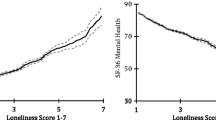Abstract
Using logit techniques and data from surveys of the elderly conducted in 1984 under the auspices of the World Health Organization, this article investigates socioeconomic, cultural, and demographic determinants of living arrangements of the elderly. Having a spouse or children with whom to live has important effects on living arrangements. The results provide only weak support, however, for hypotheses based on modernization theory and point to the need for detailed data on transitions in living arrangements and for information about the younger generation as well as the older generation, both of which are involved in deciding who lives with whom.
Similar content being viewed by others
References
Abaya, A. G. 1982. Some aspects of aging in Southeast Asia. Unites 55:225–245.
Ahn, K.-R. 1982. The situation of the aging in Korea. Unites 55:193–205.
Andrews, G. R., A. J. Esterman, A. J. Braunack-Mayer, and C. M. Rungie. 1986. Aging in the Western Pacific: A Four-Country Study. Manila: World Health Organization, Regional Office for the Western Pacific.
Chang, M.-C. 1987. Changing Familial Network and Social Welfare in Taiwan. Paper presented at the Conference on Economic Development and Social Welfare, Institute of Economics, Academia Sinica, Taipei, Taiwan.
Cowgill, D. O. 1986. Aging Around the World. Belmont, Calif.: Wadsworth.
Cowgill, D. O., and L. D. Holmes (eds.). 1972. Aging and Modernization. New York: Appleton-Century-Crofts.
Freedman, R., M.-C. Chang, and T.-H. Sun. 1982. Household composition, extended kinship and reproduction in Taiwan: 1973–80. Population Studies 36:395–411.
Greene, W. H. No date. User's Guide to LIMDEP. New York: Graduate School of Business Administration, New York University.
Hoefnagel, E. R. 1977. The Demographic Situation in Fiji. Address given at the National Seminar on Health Education and Family Health, Suva, Fiji.
Japan Statistics Bureau. 1973. 1970 Population Census of japan: Results of Detailed Tabulations. Tokyo: Office of the Prime Minister.
—. 1975. 1970 Population Census of Japan: Special Tabulation Results. Tokyo: Office of the Prime Minister.
—. 1986. 1985 Population Census of Japan: Results of the First Basic Complete Tabulation. Tokyo: Management and Coordination Agency.
Kojima, H. 1987. Parent-Child Coresidence in the Japanese Household. Paper presented at the Annual Meeting of the Population Association of America, Chicago.
Martin, L. G. 1988a. The aging of Asia. Journal of Gerontology: Social Sciences 43(4):S99-S113.
Kojima, H. 1988b. Potential Effects of Mortality Decline on the Living Arrangements of the Elderly in Four Asian-Pacific Countries. Paper presented at the International Union for the Scientific Study of Population Seminar on Mortality Transition in South and East Asia, Beijing.
— 1989. Emerging issues in crossnational survey research on aging in Asia. Proceedings of the XXIsf General Conference of the International Union for the Scientific Study of Population. Liege: IUSSP.
McDonald, P. 1987. Adjustments of Rural Family Systems to Economic and Social Change: A Review of Goode's Theory of Convergence. Paper presented at the International Union for the Scientific Study of Population Seminar on Changing Family Structures and Life Courses in LDC's, Honolulu.
Nair, S. 1985. Fijians and Indo-Fijians in Suva: Rural-urban movements and linkages. Pp. 306–445 in M. Chapman and R. M. Prodiero (eds.), Circulation in Population Movement: Substance and Concepts From the Melanesian Case. London: Routledge and Kegan Paul.
Palmore, J. A., and A. bin Marzuki. 1969. Marriage patterns and cumulative fertility in West Malaysia: 1966–1967. Demography 6:383–401.
opulation Reference Bureau. 1984. 1984 World Population Data Sheet. Washington, D.C: Population Reference Bureau.
—. 1987. 1987 World Population Data Sheet. Washington, D.C: Population Reference Bureau.
Ruggles, S. 1987. Prolonged Connections: The Rise of the Extended Family in Nineteenth-Century England and America. Madison: University of Wisconsin.
Smith, D. P., E. Carrasco, and P. McDonald. 1984. Marriage Dissolution and Remarriage, World Fertility Survey Comparative Studies 34. London: World Fertility Survey.
United Nations. 1986. World Population Prospects: Estimates and Projections as Assessed in 1984, Population Studies, No. 98. New York: United Nations.
— 1987. Global Estimates and Projections of Population by Sex and Age: The 1984 Assessment. New York: United Nations.
Wolf, D. A. 1984. Kin availability and the living arrangements of older women. Social Science Research 13:72–89.
Wolf, D. A., and B. J. Soldo. 1988. Household composition choices of older unmarried women. Demography 25:387–403.
Author information
Authors and Affiliations
Rights and permissions
About this article
Cite this article
Martin, L.G. Living Arrangements of the Elderly in Fiji, Korea, Malaysia, and the Philippines. Demography 26, 627–643 (1989). https://doi.org/10.2307/2061262
Issue Date:
DOI: https://doi.org/10.2307/2061262




